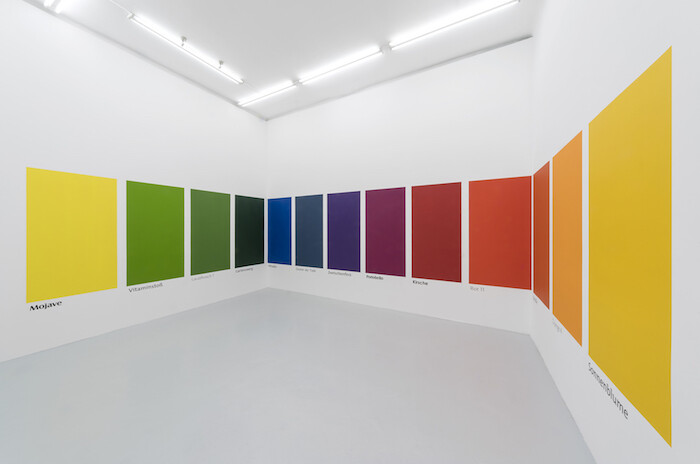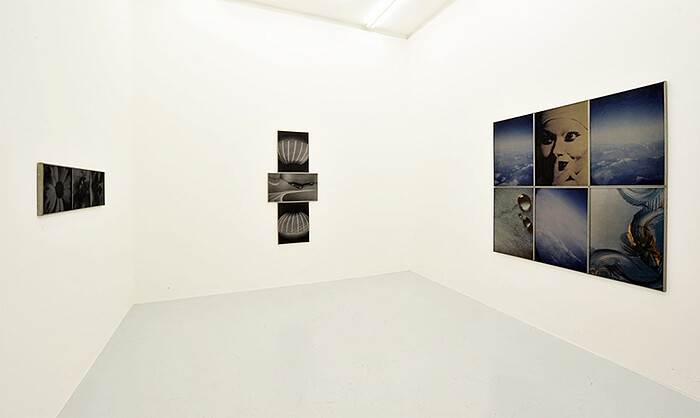Categories
Subjects
Authors
Artists
Venues
Locations
Calendar
Filter
Done
May 24, 2018 – Review
Haim Steinbach’s “Mojave”
Max L. Feldman

“Mojave” is the name of the rectangular desert-yellow color furthest to the left in Haim Steinbach’s mural eswürdesoaussehen [itwouldlooklikethis] (2018). Painted on the back wall of the gallery, this 13-color dissection of an Ellsworth Kelly painting is individuated by English translations of the Austrian names of wall paint hues (Hitradio is “Loyal Blue,” Zwetschenfleck becomes “Plum cake”) written underneath the colored squares in their manufacturers’ branded typefaces. Placed at the back of the exhibition, it is both typical of Steinbach’s non-hierarchical organization of objects in the space and of his strategy of transferring commercial materials to the walls.
Three other mural works on view—the yellow Pantone color of pantone7549c (2018), playboy of the west indies (2018), and the lion king (2018)—reflect Steinbach’s long interest in brands and consumer products, as well as his 30-year battle with Marxist critics’ dismissive use of the term “commodity art” in relation to the “extreme ambivalence” of his practice, described variously as emulating “the narcotic rhythms of the marketplace”, or being “not unlike flower arranging.” Steinbach rejects Marxist concepts like commodification and labor, but his activities—evaluating, choosing, buying, arranging, and displaying items—are just like those of the consumer. For Marx, alienated labor immiserates individuals by distorting …
January 31, 2013 – Review
Birgit Jürgenssen’s “Stoffarbeiten”
Kimberly Bradley

I thought it might be my imagination, but it seemed that every winter I happened to be in Vienna, Galerie Hubert Winter—a mod two-level space directly behind the MuseumsQuartier—was showing another exhibition by the late Austrian artist Birgit Jürgenssen, who was born in 1949. The name was the same, yet the work often varied dramatically from one show to the next. Last year, I stopped by to find out more. Yes, Jürgenssen has generally been featured in Winter’s first show annually since 2008, with each exhibition revealing one work series from the artist’s prolific output, produced (often simultaneously) throughout a career that ran from the early 1970s until her premature death at age 53 in 2003.
By now, the January slot is predictable, but it has been refreshing, sometimes astonishing, to observe Jürgenssen’s many approaches to her artistic practice (I often wonder, too, whether the artist herself would have approved of or objected to how these approaches are presented). A true multimedia artist well ahead of her time, Jürgenssen made drawings, cyanotypes, figurative and experimental photographs, text works, Polaroids, sculpture, abstract films projected onto her body, photorealism, and performance. What connects the work is a sense of womanness—beginning with the …